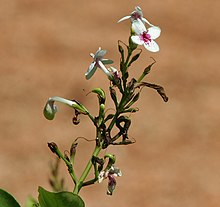Acanthaceae
In most species, the seeds are attached to a small, hooked stalk (a modified funiculus called a jaculator or a retinaculum) that ejects them from the capsule.
[3] A species well known to temperate gardeners is bear's breeches (Acanthus mollis), a herbaceous perennial plant with big leaves and flower spikes up to 2 m tall.
Some research has indicated that Acanthaceae possess antifungal, cytotoxic, anti-inflammatory, anti-pyretic, antioxidant, insecticidal, hepatoprotective, immunomodulatory, anti-platelet aggregation and anti-viral potential.
[4] For instance, Acanthus ilicifolius, whose chemical composition has been heavily researched, is widely used in ethnopharmaceutical applications, including in Indian and Chinese traditional medicine.
[9] Critically, Mendoncioideae, Thunbergioideae, and Nelsonioideae do not possess retinaculate fruits—and it is this distinction, between classifying Acanthaceae into a family that includes those clades with non-retinaculate fruits and one that excludes them, that still persists to the modern day.
[10] He placed Nelsonioideae within Scrophulariaceae, classified Thunbergiaceae and Mendonciaceae as distinct families and divided his Acanthaceae into two groups (Acanthoideae and Ruelloideae) based on the presence or absence of cystoliths, articulate stems, monothecate anthers, and colpate pollen.
In Scotland and Vollesen's 2000 study,[11] they accepted 221 genera and detailed five major groups within Acanthaceae s.s. (that is, those possessing retinaculate fruits), which is equivalent to Acanthoideae Link sensu Lindau 1895.
[12] Much research, using both molecular data and fossils, has been conducted in recent years regarding the dating and distribution of the Acanthaceae and Lamiales lineage, although there still remains some ambiguity.










